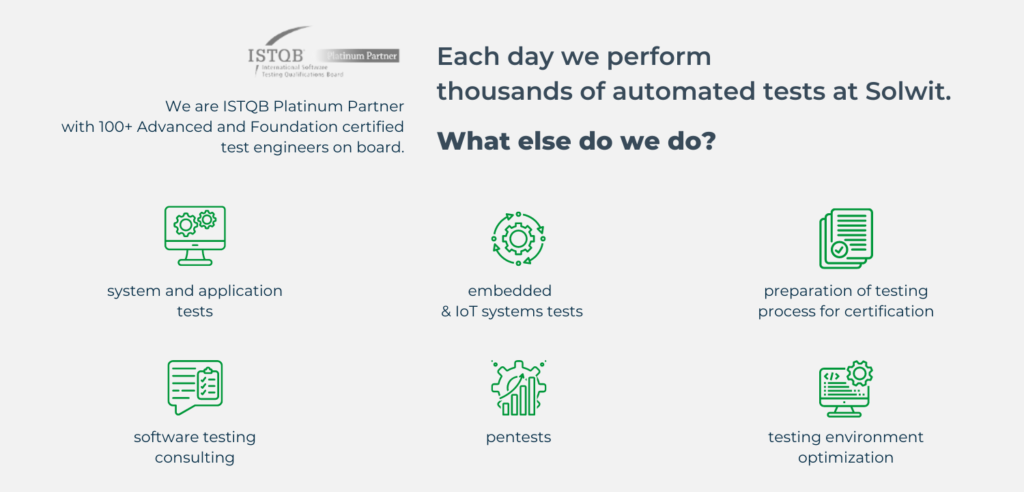
Thanks to Solwit for providing us with this blog post.
Is it possible to implement test automation without a specific plan? What should a well-prepared strategy entail? In this interview, Michal Zaczynski, Software Testing Domain Expert, talks about the pros and cons of test automation and the benefits it can bring to businesses.

What are the short-term and long-term business benefits of automated software testing?
Business benefits can only be weighed by considering test automation, technology, and tools used in creating the product. Software testing always brings profits.
For a simple website without complex business logic, created using a popular platform, we can find out the results of automated tests even within a few hours using commercial automation tools. On the other hand, in the case of more complex test items and the multitude of automation tools or customized frameworks used, this time will significantly expand – even to 2-3 months.
Despite this, it is worth noting that this is not time wasted for business. The time saved by automated testing can be used to perform other, more complex tasks.
Among the most substantial long-term benefits is quick feedback on the quality of an application, the ability to test more often, releasing manual testers’ time resources, so they can focus on areas that still need to be tested, or the ability to repeat automated tests. All this leads to a significantly improved testing process and, ultimately, a higher quality product, assuming that the reported defects are remedied.
Is test automation required for all software projects, or are there situations where it is not?
No, it is not required, and there is no business case for doing so in many cases. This is particularly true for short-term projects, where automation can take longer than product development. Another example would include strictly hardware-related projects requiring manual actions, e.g., replacing a chip, rewiring expansion cards, etc. In this situation, the cost of setting up automated software testing equipment might be too high compared to the benefits. A project focused only on the graphical part of the application (UI), which changes.
Are there some criteria (maturity or otherwise) a company/project should meet to take advantage of software test automation?
That’s definitely an in-depth business analysis and defining realistic goals based on this that we would like to accomplish through software test automation.
Is an automation testing strategy always necessary, or can we do without it, and if so, why?
The test automation strategy should include, among other things:
- defining the scope of automation and the level of testing,
- defining the framework and tools for automation,
- identifying test environments,
- creating the tests themselves and running them.
It seems impossible to complete test automation by skipping any of the above steps. Even if you run a project that is very similar to the one already implemented, using the same technologies and resources, you still analyze the development possibilities subconsciously.
It is worthwhile to keep in mind that not having a strategy can also be a strategy.
What features should companies consider when designing an automation testing strategy?
These features are due to the steps included in the automation testing strategy, as defined in the earlier question. These are:
- Test type and level.
- The test team’s resources and skills.
- The desired features of the framework and automation tools (how they will be run).
- The purpose of test automation.
How do you know your automation testing strategy is actually effective?
A strategy is appropriate when it achieves defined objectives with an acceptable ROI. In light of these two pieces of information, we can say without a doubt that the automation path chosen is the right one.
What best practices or trends are you witnessing in the software testing automation field?
The context of recent trends suggests that many tools are adopting AI and taking a codeless approach to capture the market. Although they haven’t yet dominated the market, they are certainly growing in popularity. Their high license costs hinder their use, often linked to the number of automated tests created. It would also be worth mentioning the Playwright framework (open source), something the testing community has been hearing more and more about.
Many good practices exist, but they can all be combined into one – treat test automation like any other development project, following the same principles. This approach eliminates the need to re-solve old and familiar problems when developing applications or writing automated tests.
If you are seeking a technology partner to test your software, get in touch with us! We have successfully completed many projects that required the execution of automated tests, the choice of the right type of tests, the selection of the right tools, or creating them from scratch. We will be more than happy to tell you how to get it done. Set up a free consultation!

Author

Michał Zaczyński – Software Testing Domain Expert
Michał Zaczyński – has been with Solwit for over ten years. He’s a flesh and blood tester – his experience includes Quality Assurance activities, work with IEEE/ISO standards, and supervision of test projects. In his view, a competent specialist combines practical experience with theoretical understanding, seasoned with a dash of “that something” one must possess.
Solwit is an EXPO Exhibitor at EuroSTAR 2023, join us in Antwerp